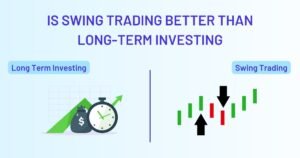Are you torn between the tantalizing thrill of swing trading and the steady, patient approach of long-term investing? You’re not alone. Many investors find themselves debating these two popular strategies as they navigate through the ever-changing terrain of the stock market. Swing trading offers a chance for quick profits while long-term investing promises stability and growth over time. But which path is right for you? Let’s dive into each strategy, uncover their advantages and drawbacks, and help you determine if swinging or settling is your best bet in this financial arena.

Understanding Swing Trading and Long-Term Investing
Swing trading is a strategy that involves holding stocks for a short period, typically days or weeks. Traders capitalize on price fluctuations by entering and exiting trades based on market trends and technical analysis. This approach demands quick decision-making and a keen eye for patterns.
On the other hand, long-term investing is all about patience. Investors buy stocks with the intent to hold them for years, focusing on fundamental performance rather than daily price movements. This strategy aims to benefit from compounding returns over time.
Both methods have their unique appeal. Swing traders thrive on action and rapid results, while long-term investors enjoy the calm of watching their investments grow steadily in response to broader economic shifts. Each path requires different skills and mindsets tailored to individual risk tolerance and financial goals.
Advantages of Swing Trading
Swing trading offers a unique opportunity for traders to capitalize on short-term movements in the stock market. This approach can lead to higher potential gains compared to traditional investing methods.
One significant advantage is the ability to make quick profits. Traders can enter and exit positions within days or weeks, allowing them to take advantage of price fluctuations that occur over shorter periods.
Flexibility is another key benefit. Swing traders can adjust their strategies based on current market conditions or individual asset performance. This adaptability allows them to respond swiftly, seizing opportunities as they arise.
Additionally, swing trading encourages active engagement with the markets. For those who thrive on action and analysis, it provides an exciting environment where decisions must be made quickly and strategically. The thrill of trading adds an extra layer of excitement not typically found in long-term investing approaches.
– Higher potential for short-term gains
Swing trading thrives on the potential for short-term gains. Traders capitalize on market volatility, aiming to make profits from price movements over days or weeks.
This method provides opportunities to seize quick profits without holding positions long-term. With precise timing and analysis, swing traders can lock in gains before a stock’s movement reverses.
The thrill of capturing these rapid fluctuations is appealing. It allows traders to be more engaged with their investments. Each trade becomes an exciting challenge rather than a waiting game.
Moreover, short-term gains can significantly boost overall portfolio performance. By leveraging technical indicators and chart patterns, savvy swing traders often find profitable entry and exit points that long-term investors may overlook.
This strategy suits those who thrive in dynamic environments where they can swiftly react to market shifts.
– Flexibility in trading strategy
Flexibility in trading strategy is a standout feature of swing trading. Unlike long-term investing, where your positions are often static for months or years, swing traders can adapt quickly to market changes. This agility allows them to capitalize on short-term price movements.
Traders can switch between different assets and sectors based on current trends. If one stock isn’t performing as expected, they have the freedom to explore other opportunities without being locked into a lengthy commitment.
Additionally, swing traders can employ various strategies depending on market conditions—be it momentum trading or mean reversion tactics. This adaptability enhances their chances of maximizing profits while minimizing losses.
The ability to pivot creates an exciting environment for those who thrive on action and quick decision-making in the stock market. It fosters creativity and encourages continuous learning about new techniques and tools that can aid in making informed decisions swiftly.
Drawbacks of Swing Trading
Swing trading can be an enticing strategy for many, but it comes with significant drawbacks. One of the biggest challenges is the risk involved. Prices in the stock market can fluctuate wildly over short periods, leading to potential losses that can pile up quickly.
Another concern is the time commitment required. Successful swing traders need to monitor their trades and analyze market trends frequently. This level of engagement might not suit everyone’s lifestyle or preferences.
Emotional decision-making often plays a role too. The stress from rapid price changes can lead some traders to make impulsive choices, deviating from their original strategies.
Transaction costs may eat into profits as well. Frequent buying and selling incur commissions that accumulate over time, impacting overall returns on investment significantly.
– Higher risk of losing money
Swing trading often attracts those looking for quick profits. However, this approach comes with its own set of challenges.
The volatility in the stock market can be a double-edged sword. While it creates opportunities for gains, it also heightens the risk of significant losses. A sudden price drop can wipe out potential profits and lead to financial setbacks.
Traders need to stay alert and make swift decisions. This constant pressure can lead to emotional reactions rather than calculated moves. Relying on instinct rather than strategy increases exposure to loss.
Moreover, without careful analysis and research, traders might enter positions that seem promising but quickly turn unfavorable. The fast-paced nature of swing trading demands not just knowledge but also discipline—a tough combination for many investors navigating the unpredictable landscape of stocks.
Benefits of Long-Term Investing
Long-term investing offers a wealth of advantages that can appeal to many investors. One significant benefit is the reduced stress associated with daily market fluctuations. Unlike short-term traders, long-term investors can ignore noise and focus on their strategy.
This approach allows for a more patient mindset. Investors are not constantly reacting to every slight dip or rise in stock prices. Instead, they concentrate on broader trends and company fundamentals.
Additionally, the power of compounding plays a crucial role in building wealth over time. By holding onto investments for years or decades, gains can snowball into substantial returns.
Tax efficiency is another notable advantage; longer-held assets typically incur lower capital gains taxes compared to frequent trading activity. This means you keep more of your profits while also promoting financial stability and growth in your portfolio.
– Less stress and emotional attachment to market fluctuations
Long-term investing provides a sense of stability that many traders crave. When you buy and hold stocks for years, daily market fluctuations become less significant.
With this approach, investors often feel detached from the stress of constant monitoring. They’re not glued to their screens every minute, reacting impulsively to price changes.
Instead, long-term investors focus on broader economic trends and company fundamentals. This perspective allows them to ride out volatility without panic selling or second-guessing decisions.
Emotional attachment can cloud judgment in trading. Long-term strategies help mitigate this risk by fostering patience and discipline. Investors are more likely to remain steadfast during downturns when they have a longer time horizon in mind.
This mindset encourages thoughtful decision-making rather than knee-jerk reactions driven by fear or greed. In turn, it creates an environment where investment goals align with personal financial aspirations over time.
Downsides of Long-Term Investing
Long-term investing has its own set of challenges. One significant drawback is the potential for missed opportunities. While you hold onto investments for years, market conditions can change rapidly. New technologies and emerging companies may offer better returns that long-term investors might overlook.
Another downside is the impact of inflation over time. Although stock values can increase, if they don’t outpace inflation, your purchasing power could diminish in the long run. Additionally, markets can experience downturns that last longer than expected, testing even the most patient investor’s resolve.
Long-term strategies require discipline and a strong belief in your investment choices. This dedication isn’t easy when faced with negative news cycles or economic uncertainty. Emotional reactions can lead some to abandon their strategy prematurely.
While both swing trading and long-term investing have merits and drawbacks, understanding these factors will help you make informed decisions tailored to your financial goals within the stock market landscape.

